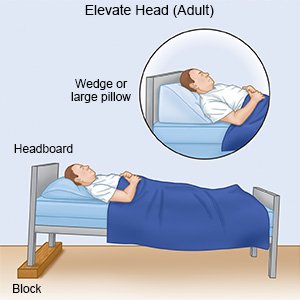Septorhinoplasty
Medically reviewed by Drugs.com. Last updated on Aug 4, 2025.
Septorhinoplasty is surgery to repair or straighten a deviated septum, or change the appearance of the nose. The nasal septum is the cartilage and bone that forms a wall to separate your nostrils. Septorhinoplasty may relieve symptoms such as trouble breathing, dry mouth, or frequent nasal congestion.
DISCHARGE INSTRUCTIONS:
Call your local emergency number (911 in the US), or have someone call if:
- You have trouble breathing.
Seek care immediately if:
- Clear fluid comes out of your nose when you bend your head forward.
- Your heart is beating fast or has an irregular rhythm.
- Your nose or the roof of your mouth is pale or starting to turn black.
- You have severe pain.
- You have red streaks on the skin around your nose.
Call your surgeon if:
- Blood soaks through your bandage.
- Your splint or support device comes off.
- You have a fever or chills.
- Your surgery area is red, swollen, or draining pus.
- You have nausea or vomiting.
- Your eyes are red, itchy, swollen, or draining pus.
- You have questions or concerns about your condition or care.
Medicines:
You may need any of the following:
- Nasal sprays may be prescribed to help decrease swelling and congestion.
- Antibiotics help treat or prevent an infection caused by bacteria.
- Prescription pain medicine may be given. Ask your healthcare provider how to take this medicine safely. Some prescription pain medicines contain acetaminophen. Do not take other medicines that contain acetaminophen without talking to your healthcare provider. Too much acetaminophen may cause liver damage. Prescription pain medicine may cause constipation. Ask your healthcare provider how to prevent or treat constipation.
- NSAIDs , such as ibuprofen, help decrease swelling, pain, and fever. NSAIDs can cause stomach bleeding or kidney problems in certain people. If you take blood thinner medicine, always ask your healthcare provider if NSAIDs are safe for you. Always read the medicine label and follow directions.
- Take your medicine as directed. Contact your healthcare provider if you think your medicine is not helping or if you have side effects. Tell your provider if you are allergic to any medicine. Keep a list of the medicines, vitamins, and herbs you take. Include the amounts, and when and why you take them. Bring the list or the pill bottles to follow-up visits. Carry your medicine list with you in case of an emergency.
Self-care:
- Do not blow your nose. The increase in pressure can cause your nose to bruise, swell, or bleed. Try not to sneeze. If you have to sneeze, keep your mouth open to decrease pressure in your nose.
- Elevate your head and upper back. Place extra pillows under your head, neck, and shoulders when you sleep in bed. Try not to bend your neck. Elevation will help decrease swelling.

- Apply ice. Do this for 15 to 20 minutes every hour for the first day. Use an ice pack, or put crushed ice in a plastic bag. Cover the bag with a towel before you apply it on your nose. Ice helps prevent tissue damage and decreases swelling and pain.
- Care for your surgery area as directed. Rinse your nose with saline 1 or 2 times a day, or as directed. Mix ½ teaspoon of salt and ¼ teaspoon of baking soda with 1 cup of warm distilled water. Nose rinses help remove crusts and prevent infection. Apply petroleum jelly to your nostrils after you rinse your nose. You may have gauze taped under your nostril openings. Change the gauze if it gets wet or dirty. If you have a splint, do not get it wet or try to remove it.
- Use a cool mist humidifier. A cool mist humidifier will increase air moisture in your home. This will help keep your nose and throat moist and prevent irritation.
Follow up with your surgeon as directed:
You may need to return to have your gauze or splint removed and the surgery area checked. Write down your questions so you remember to ask them during your visits.
© Copyright Merative 2025 Information is for End User's use only and may not be sold, redistributed or otherwise used for commercial purposes.
The above information is an educational aid only. It is not intended as medical advice for individual conditions or treatments. Talk to your doctor, nurse or pharmacist before following any medical regimen to see if it is safe and effective for you.
Further information
Always consult your healthcare provider to ensure the information displayed on this page applies to your personal circumstances.
